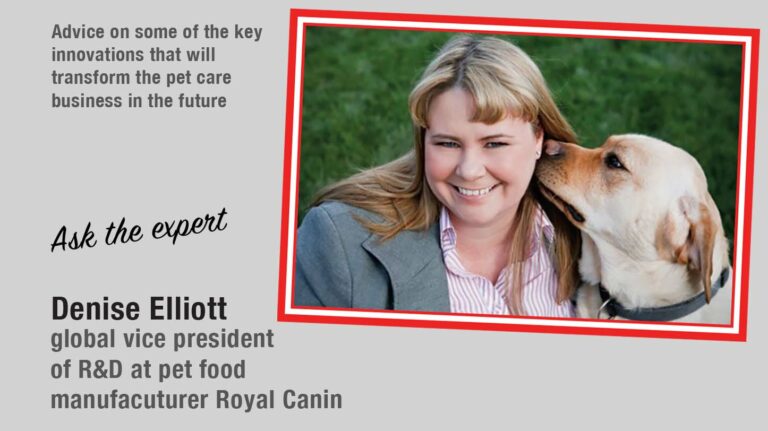Denise Elliott is global vice president of R&D at pet food manuafcturer Royal Canin. Here, she explains how increased use of technology is driving new breakthroughs in pet health, wellbeing and nutrition.
R&D is driving the future of pet health
We live in an age of unprecedented technological advances that allow us to know more about the health of our cats and dogs than ever before. But what do pet professionals do with that knowledge? How can leaders in veterinary medicine and information technology come together to design innovative solutions to help pets live long and healthy lives?
A starting point to this mission is another question: where and how should we look for the next breakthrough? I’ve learned in my years leading the R&D division of Royal Canin, a global expert in health through nutrition, that our best innovations come by building small and agile teams that can work outside of traditional research and development processes to explore untapped areas for cutting-edge science and technology. In the same spirit, our division also regularly seeks external partnerships and collaborations from academia, government, industry and even startups.
We host the Royal Canin Vet Symposium each year largely for this purpose, bringing together thousands of vets from over 90 countries to interact with some of the leading experts in the world and our team of experts committed to advancing pet health.
From telemedicine to wearable tech
Having worked as a vet myself, combined with my time as a researcher at the Waltham Petcare Science Institute in Leicestershire, and now in the pet nutrition industry, this has given me a broad view to see where the most important innovations are heading. Those include some mind-bending breakthroughs in telemedicine, wearable tech and artificial intelligence, and connected devices. Other advances in providing 360-degree care include dog trackers – not unlike ones that humans have on their smartphones – that can monitor a canine’s activity, like sleeping patterns. We know, for example, increased sleeping could be a sign of pain and joint disease.
Understanding patterns and irregularities in our animals’ lives can help us better figure out their needs and know when to seek veterinary help. This is especially important for cats, who often hide their pain. One of the most exciting new products for felines are granules for litter boxes that turn blue if the cat’s urine contains blood traces, which has multiple causes and the underlying illness can be difficult to diagnose.
Algorithms developed in partnership with the Royal Veterinary College are also helping to predict kidney disease in cats. In the past, this common ailment was most often diagnosed too late for preventative treatment, but new algorithms can identify risks for kidney disease 12-15 months before cats have clinical signs.
Of course, some vets have concerns about whether automation and increasingly available information will make our jobs obsolete. But new technology also has the potential to improve our workflow and allow vets to focus on what matters most: the connections we build with our patients. The pandemic has proven the power of telemedicine to provide remote consultations with ease to both the doctor and the client, who can receive care from the comfort of their own home.
The power of individualisation
I believe the future of veterinary medicine is built on tech… and love! It was a pleasure to discuss this topic this year with thousands of pet professionals that joined our 2021 Vet Symposium.
Some of the most exciting changes are in nutrition and medical tools for our cats and dogs that adapt to the individual animals they are, recognising that each pet’s health needs are driven by a unique combination of circumstances and characteristics. In the past, pet nutritionists tended only to address one pathology at a time, be it obesity, mobility, dermatology, or kidney disease. Yet some one-third of dogs and cats suffer from multiple pathologies that one existing pet food product alone cannot necessarily support.
Royal Canin spent seven years researching how to formulate a nutritional solution that could provide a bespoke diet for each pet’s particular requirements. Mathematicians used big data to formulate multiple nutrition combinations, taking into account traits including age, weight, breed, gender, neutering status, and risk factors.
The result is Royal Canin Individualis, which launched in 2019 and is currently available in 12 European countries, including the UK. Royal Canin Individualis was developed using Royal Canin’s innovative algorithms that incorporated input from our network of veterinary partners around the world. As part of the nutritional support for complicated cases and conditions, vets can then adopt an ‘Individualis’ diet based on the animal’s needs and response.
Helping those who help us
Looking forward, I’m also excited about ways we can help the animals who help us, like dogs who can detect illnesses like Covid-19 in humans, assist people living with disabilities or provide rescue support during emergencies. It’s our responsibility to speak on their behalf and help make their lives better.
Animals can bring so much joy to our lives, something I’ve seen over the years working in veterinary research. Every day, I see the potential of tapping into big data to help improve the health of pets. Still, the innovations driven by data and artificial intelligence are only useful if the people using them are working to the best of their abilities. I am fortunate that my work today combines my dual passions for pet nutrition and data science, along with a fundamental belief in the ability of teams (of humans!) to drive innovation.



